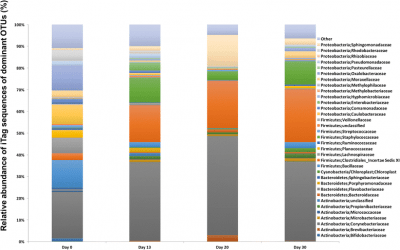In order to establish long-term habitation in space, it will be necessary to construct safe, self-contained living enclosures, and to understand the potential microbial presence in those spaces. Therefore it is useful to construct analogous living enclosures on Earth to mimic the conditions for astronauts on the moon or Mars, and perform microbial rRNA sequencing analysis before and after human habitation.
In an article in the June 2016 issue of Microbiome, Mayer and colleagues from the Jet Propulsion Laboratory at Cal Tech prepared a bleach-cleaned habitat containing sleeping compartments, bathroom, dining room and laboratory. Over the course of 30 days, a crew of students inhabited the structure, and collected samples at different locations and times. The samples were analyzed in various ways including traditional culturing methods and total microbe levels measured by ATP. In order to get more quantifiable information they also treated the samples with PMA and performed both qPCR and Illumina sequencing to identify the bacterial species present, as well as their viability status.
The sequencing results show the effects of humans on the bacterial population. In the samples collected after human habitation, the authors found viable bacteria known to be associated with humans, both commensal and pathogenic. Previous studies yielded similar results, but did not measure the viability status of the microbes, which the authors argue provides crucial information about the microbial population dynamics. The data from this study should inform any future space habitations, in terms of cleaning procedures and monitoring protocols.
Read the original article, Microbial succession in an inflated lunar/Mars analog habitat during a 30-day human occupation.
Mayer T, et al. Microbial succession in an inflated lunar/Mars analog habitat during a 30-day human occupation. Microbiome. June 2016. DOI: 10.1186/s40168-016-0167-0

To learn more about viability PCR using the dyes PMAxx™ or PMA.

